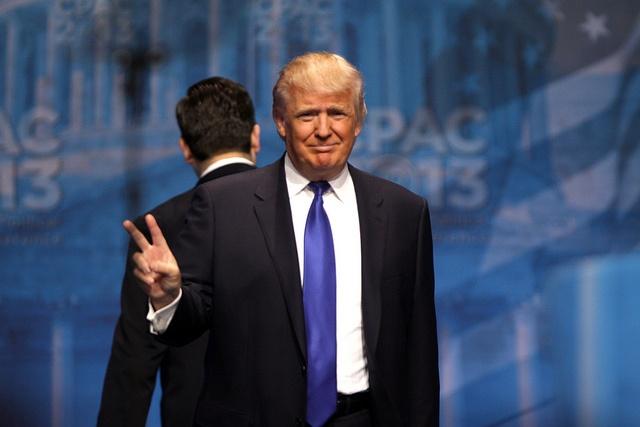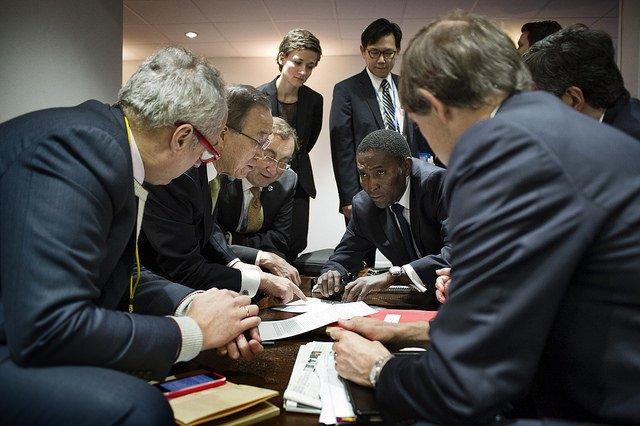Trump Can’t Derail Paris Climate Agreement


Republican presidential candidate Donald Trump says he would renegotiate the U.N. global climate deal, or at least America’s role in it.
“I will be looking at that very, very seriously, and at a minimum I will be renegotiating those agreements, at a minimum. And at a maximum I may do something else,” Trump told Reuters earlier this month. "But those agreements are one-sided agreements and they are bad for the United States.""Not a big fan because other countries don’t adhere to it, and China doesn’t adhere to it, and China’s spewing into the atmosphere," he continued.
The climate agreement, signed by representatives from 175 countries in April, seeks to keep global temperature rise to 2 degrees Celsius. Both the Obama administration and China made big pledges. The U.S. pledged to reduce greenhouse gas (GHG) emissions by 26 to 28 percent by 2025 from 2005 levels, while China pledged to stop increases in carbon emissions by 2030.
Reuters pronounced that a pull-out by the U.S., the world’s second largest GHG emitter, “would hobble the deal reached in Paris last December.” But British climate change expert Tom Burke disagrees, as he told Climate News Network. Burke, who formerly headed Friends of the Earth U.K. and now serves as chairman of the environmental group E3G, called Trump’s statements a “vacuous piece of posturing.” To Burke, Trump’s claims that he would renegotiate the climate deal are just “a message to his potential supporters on the political right.”
“Who would he renegotiate the Agreement with? He can’t renegotiate on his own, and the rest of the world is moving on,” Burke said. “Trump can repudiate the Agreement, but it won’t make a scrap of difference to the rest of the world.”
Burke suggested that Trump “can do what George W. Bush did when he was president: He can withdraw the U.S. from its obligations, as Bush did with the Kyoto Protocol." He added that “Trump can repudiate the Agreement, but it won’t make a scrap of difference to the rest of the world.” The reason is that the drive toward a low-carbon economy is "being propelled, not by law, not by constraints, but by opportunity,” Burke said.
Trump protects his own property from climate change effects
Trump has referred to climate change as a “total hoax,” “bullshit” and “pseudoscience." Meanwhile, he wants to construct a sea wall to protect a Trump International golf resort in County Clare, Ireland, from “global warming and its effects,” Politico reported.
Politico points out the irony of Trump making disparaging comments publicly about climate change while seeking to protect one of his properties from its impacts. “His public disavowal of climate science at the same time he moves to secure his own holdings against the effects of climate change also illustrates the conflict between his political rhetoric and the realities of running a business with seaside assets in the 21st century,” Politico reporter Ben Schreckinger wrote on Monday.
Former South Carolina congressional member, Rep. Bob Inglis, a Republican, called Trump’s hypocrisy on climate change “diabolical.” He said Trump “is working to ensure his at-risk properties and his company is trying to figure out how to deal with sea level rise.” He pointed out that “it’s conceivable that he might swing around on this.” And the reason why is that “it would be a smart political move for him or for anyone because that’s where the public’s already going.”
And that is where businesses are going too. A 2016 PwC survey found that, out of 1,409 CEOs surveyed in 83 countries, half think climate change is a threat to their businesses' growth prospects. Clearly, Trump agrees with the CEOs surveyed, as his application for a seawall to protect his Irish resort shows, although he won't cop to it publicly.
Image credit: Flickr/Gage Skidmore
Pakistan Aims to Plant a Billion Trees in a Green 'Tsunami'


Pakistan has its sights set on an ambitious effort to help the country recover from years of rampant deforestation and increase resilience to floods, droughts and other extreme weather events expected to increase with climate change.
Pakistan has a sordid history of environmental degradation. Since gaining independence from Britain in 1947, the densely-populated South Asian nation saw nearly all of its primary forests cut down while its population grew by an astounding 600 percent.
More recently, the country began to feel the brunt of extreme weather events linked to climate change. In 2014, massive flooding resulted in hundreds of deaths, and thousands more were displaced. Northern Pakistan, the focus of the project -- aptly named the 'Billion Tree Tsunami' -- faces even more extreme, immediate challenges, including frequent landslides.
This will only get worse, as the country is heavily dependent on water from Himalayan glaciers during dry seasons. As climate change warms the world's highest mountain range, Pakistan will be impacted with more unreliable water resources.
All these impacts are made worse by deforestation, which further limits the ability of land to hold water -- making floods more likely and droughts more extreme. That is why the government embarked on this plan, working with numerous global NGOs to help restore Pakistan's environment.
“By planting trees, we have supported biodiversity, restored degraded forests, revived rural communities and provided carbon sequestration to combat climate change,” said David Boyer, director of the Aga Khan Fund for the Environment, one of the organizations that's helping to plant trees in Pakistan, in a press statement.
A billion trees sounds like a lot, but the question is whether this is merely a political symbol or real action. So far, the progress sounds steady, and the commitment seems real.
"The project kicked off in June 2015 and so far 250 million saplings have been raised in largely private nurseries across [northwestern Khyber Pakhtunkhwa province]. These saplings are now being planted across the province," Rina Saeed Khan of The Third Pole, a multilingual platform dedicated to the Himalayan watershed, wrote in a blog post."The remaining 450 million saplings are being naturally generated in forest enclosures, which are being protected through the participation of local communities. All this will hopefully allow [Pakistan] to achieve its target of 1 billion plantations by the end of next year."
Also quite heartwarming is that the opposition is also calling for their own plan to green the country. Imagine that: two political parties fighting with each other to be more green. Why can't we have this in America?
The plan is not without its drawbacks, though. For example, it makes far too heavy use of non-native plants, including the notorious eucalyptus tree -- which we here in California are all too familiar with. Though it is fast-growing and provides usable wood quickly, it's deep roots can quickly deplete water tables and impact the ability of other plants to grow. In water-scarce regions, this tree can cause more harm than good.
Using native plants would be better, as they are acclimated to the climate and geography and stand to produce more environmental benefits.
Nevertheless, Pakistan's Billion Tree Tsunami is a step forward. And it's the first of what must be many massive environmental restoration projects around the world -- to not only rehabilitate degraded land, but also help us prepare for the inevitable climate impacts.
Photo Credit: Usman Liaquat via Wikimedia Commons
Putting a Value on Climate Adaptation


By Chen Chen
The Paris Climate Agreement put climate adaptation squarely on the climate agenda when it established a global goal to “enhance adaptive capacity, strengthen resilience and reduce vulnerability to climate change."
Through the agreement, funds from developed countries are pledged to fuel adaptation planning and implementation in vulnerable, developing countries. Similar to other issues related to global development, garnering monetary pledges could be the crucial first step toward positive change. But what can we expect to come out of the multibillion-dollar pledge for adaptation?
If we look at typical development projects, we can anticipate the output of development investment because the unit costs of the projects are often provided, as in anti-malaria efforts in Malawi or DRC, or learning opportunities for refugee children in Syria. We must now ask: What is the unit cost of improving adaptive capacity or reducing climate vulnerability? No such measure yet exists, making it difficult to identify measurable goals for adaptation funds.
In a recent webinar hosted by the Notre Dame Global Adaptation Index (ND-GAIN), private-sector, climate-adaptation investment mavens discussed how an adaptation assessment measure could inspire a larger market to meet the needs of the developing world. The creation of a Common Adaptation Unit (CAU) allows us to quantify the adaptation goals. This discussion inspired me to consider the steps needed to conceptualize a measurement unit for adaptation based on the three years of inquiry leading ND-GAIN’s research on adaptation measurement at the global, country, city and project evaluation levels.
A critical step is to derive a per-unit measure that is comparable to outputs in a typical development project, such as the number of insecticidal nets distributed or the number of refugee children gaining learning opportunities.
The impacts of climate change manifest in two ways – through climate-induced shocks such as extreme weather and climate disasters like floods or landslides, and climate-imposed stresses such as shortened growing seasons or extended disease transmission periods, both of which could take an enormous toll on lives and assets. Adaptation success can therefore be measured using the number of lives saved or assets value preserved. However, this way of quantifying adaptation success would be comparable to measuring the outcomes of usual development projects (e.g., increased retention rates of school children due to funding to improve education accessibility), which requires a complete cycle of project impact evaluation to quantify such unit.
The improvement of adaptive capacity or reduction of vulnerability is the intermediate step leading toward a scenario where climate disasters cause less or no damage to lives and assets. Therefore, what we need is a unit to measure the intended “output” from adaptation funds in its immediate form, a unit by which taxpayers understand what the funds are going to be spent on.
This novel CAU would quantify the progress of adaptation. As a standardized measure, the use of this CAU would precede the measures of lives and assets impacted by climate change. It can be helpful to think of the CAU as similar to Intelligence Quotient (IQ). One common feature of CAU and IQ is that they both measure something that only exists conceptually. Some standardized tests can gather key information from an individual to measure IQ. Similarly, standardized tests, in a form of standardized surveys, can be given to a country or a community to measure CAU.
City surveys have been gathering data on the perception of climate risks and adaptation planning that can serve as the basis for a CAU for certain cities. Although further quantification challenges remain to formalize the unit, standardized surveys that quantify adaptation progress at multiple scales will bring us closer to developing a baseline for adaptation and to a setting adaptation targets.
Using standardized survey to obtain a measurable state of vulnerability can help global adaptation leaders realize many uses of CAU, as listed in its concept note, including providing a target to guide future Conference of the Parties similar to greenhouse gas mitigation targets. We can then estimate the cost of improving a country’s, city’s, or community’s CAU and know what outputs we can expect from monetary pledges for adaptation.
Image credit: Flickr/COP21 Paris
Chen Chen is the research scientist at Notre Dame Global Adaptation Initiative’s (ND-GAIN) and Notre Dame Initiative for Global Development, focusing on adaptation measurement at various scales to serve a prospective adaptation market.Partnerships, localism and circularity help businesses scoop National CSR awards


By Tom Idle - Presiding over the 2016 National CSR Awards – now enjoying its second year as an useful addition to the initiatives that recognise best practice in sustainability – host Ed Gillespie asked delegates, "Consider which side of history do you want to be on"?
Those picking up their trophies at a reception, aptly held inside Siemens' The Crystal (said to be the world’s greenest building), had chosen the right side by “trusting their gut and imagining better,” said Gillespie.
When considering most of the organisations, projects and partners that had reason to celebrate this year, a  clear trend to emerge was a focus on localism. Being sure to create the most social value within local communities, where it matters most, was a key reason the Midcounties Co-operative scooped the Overall Excellence in Social Responsibility Award – a category supported by Nottingham University Business School, which offered up discounted placements for Midcounties staff as part of the prize.
A focus on connecting the business to the community was also key to David Fawcett’s success in winning the Outstanding Individual Corporate Leadership award for the infrastructure business Amey. Driving Amey’s apprenticeship programme to target areas of high unemployment across Hampshire, he is proving business can be a force for good and contribute positively to solving the UK’s wider social problems.
Other award-winning entries – from Braiform’s decision to set up a closed-loop clothes hanger re-use programme (winner, Reduce, Reuse, Recycle Award), to Élan Hair Design’s £250,000 salon refurbishment making it the UK’s most eco-friendly hair salon (winner, Clean and Green Award) – pointed to significant investments.
And with global retailer Primark (runner-up, Best International Sustainability Award) and European media business Sky(winner, Best International Sustainability Award (Legacy), there is plenty of evidence that businesses with scale, reach and impact are using it, in some instances, to transform entire sectors.
Echoing current sentiment that business collaboration is the panacea for solving all of our environmental and social ills, organisations like Legal & General (highly commended, Best Individual Community Project Award) and Halfords (winner, Best Partnership in the Community Award) are proving that there’s plenty of merit to forming partnerships.
Other recognised organisations included: Brand Addition (winner, Innovation for Workplace Practices Award); Warburtons (winner, Nutritional & Health Awareness Award); Global Action Plan (special judges award, ‘Education Across Waters’ Award); Tata Consultancy Services (winner, Best Education Award); Riversimple (runner-up, Clean and Green Award); Melton Foods (runner-up, Reduce, Reuse, Recycle Award); London Stansted Airport (winner (large), Best Individual Community Project Award); Hubbub (winner (small), Best Individual Community Project Award); Deutsche Bank & Sported (highly commended, Best Partnership in the Community Award); Jaguar Land Rover (winner, Best International Sustainability Award); and, UBS (winner, Best Community Development (Legacy)).
All of the details of this year’s winners can be found on the National CSR Awards website. For more on The Midcounties Co-operative, see this month’s interview with social responsibility manager, Mike Pickering.
Photo: Ingrid Weel Media Ltd. http://www.ingridweel.com/
Are We Nearing Peak Oil?


According to Bernstein Research, peak oil – when oil usage is expected to begin falling globally – could arrive as soon as 2030. While this may seem unlikely with low prices and plentiful supply today, it is not only possible, but also necessary.
If this sounds like deja-vu for you, it probably is. For years, we've heard predictions about peak oil, including during the last “boom” a few years, when oil prices hit $150 a barrel on fears that supply would never catch up to demand. Even the 1970s OPEC oil embargo was hailed by some as peak oil (we've nearly doubled oil consumption globally since then).
Oil today is cheap and plentiful, and it's hard to imagine that it is anywhere near peaking, especially with countries like Saudi Arabia and, soon, Iran looking to increase production in the coming years. Moreover, new technologies such as oil sands extraction and more complex offshore drilling are making more and more oil resources exploitable, one reason known reserves continue to climb. Even at $25 a barrel, Saudi Arabia can make profits.
So, why does Bernstein Research think that oil will peak? Partly because, in some parts of the world, it already has. The global North, for example, peaked in 2005. All the growth since then has come from the global South -- most notably China and India -- and Bernstein expects those countries to begin shifting away from oil in the coming decade.
A few factors will work to level out that demand growth. Increased fuel efficiency and the diversification of fuels used to power the world will keep prices below the peaks we saw over the past decade. This includes everything from liquefied natural gas and diesel to electric vehicles.
One scenario that oil could follow is that of its fellow polluting commodity, coal. A decade ago, few expected the cheap, plentiful fossil fuel was anywhere near its peak. Yet, due to a wide variety of factors, coal has not only peaked globally, but it has begun to fall off a cliff.
This brings up a key point. Peak oil does not necessarily mean, as we once thought it did, that we have consumed the majority of the world's oil resources. It merely means that our usage of it has peaked. Coal remains plentiful, and even here in the United States, where we've mined the dirty fossil fuel for generations, the vast majority of it remains underground -- where it will likely stay.
Could oil follow this path? Actually, it's not theoretical. It must. We need to pretty much stop burning fossil fuels within the next decade, and certainly before 2030, to have any chance to stay below the 1.5 degrees Celsius limit that has become the scientific consensus on allowable warming. All these factors can come together and help wean the global economy from oil.
“We can see a plausible future in which global oil demand peaks in the next decade due to major improvements in petroleum alternatives, and due to ongoing conservation and efficiency efforts,” lawyer and energy expert Tam Hunt wrote of Bernstein's findings on GreentechMedia.
Peak oil, coming soon. Otherwise, kiss global climate goals, and any hope for sustainability, goodbye.
Image credit: via Wikimedia Commons
Airbnb Hit With Racial Discrimination Suit


Is Airbnb allowing hosts to discriminate against potential guests based on their race? A recently filed lawsuit alleges that it does.
Filed by 25-year-old Virginia resident Gregory Selden, the suit claims Airbnb violated his civil rights. Selden planned a trip to Philadelphia in March 2015 and tried to book accommodation through Airbnb, a sharing economy platform that allows hosts to list everything from guest rooms to second homes and investment properties.
Selden signed up for Airbnb on his smartphone through Facebook and used the app to book accommodation. His Facebook profile included his profile picture and other personal details such as his name, sex and age. He inquired about the availability of a Philadelphia accommodation from an Airbnb host agent, but his request was rejected.
Soon after being rejected, Selden noticed the same listing was available. He then created two fake profiles: one for a young white man and another for an older white man. He used the profiles to request accommodations for the same dates and from the same Airbnb host agent that rejected his request. Both of the imitation accounts were accepted.
Selden then contacted Airbnb, but the company did not respond, so he confronted the Airbnb host agent that rejected him. The host agent stated that Selden or “people like [him] were simply victimizing [himself],” according to the lawsuit. Since Airbnb didn’t respond to Selden, he went on Twitter and “spawned the viral hashtag" #AirbnbWhileBlack, which had “thousands of retweets from individuals who experienced the exact same disparate treatment from Airbnb,” the lawsuit states.
The lawsuit was filed last week, which just so happens to coincide with the anniversary of two landmark Supreme Court decisions related to civil rights: Plessy v. Ferguson and Brown v. Board of Education. In 1896, the Supreme Court ruled under Plessy v. Ferguson that the “separate but equal” policy was legal in public facilities, including schools, essentially upholding state segregation laws. In 1954, the Court reversed the Plessy ruling under the Brown ruling, which declared segregation in public schools unconstitutional. We have come a long way since 1954, but clearly we haven't come far enough.
A study published in January found that requests for Airbnb accommodations from people with “distinctively African-American” names were about 16 percent less likely to be accepted than “identical guests with distinctively white names.” And that costs the hosts, the study found, because those who reject African-American guests can only find a replacement guest 35 percent of the time.
Airbnb claimed in a blog post that it is dealing with discrimination. Titled, “A Fair Community for Everyone,” the post mentions recent “reports about people who were discriminated against because of their race when they tried to book an Airbnb listing.”
Claiming that racial discrimination is unacceptable at Airbnb, David King, the company's director of diversity, went on to list the ways it is addressing the issue. These include:
- Unconscious bias training: Airbnb made unconscious bias training available to over the 5,000 hosts who attended the Airbnb Open, an annual host convention. Airbnb will conduct training for hosts in “key markets and through webinars before the end of the year,” King wrote.
- Increased focus on reviews: The company plans to put a bigger spotlight on reviews, King wrote, citing research Airbnb conducted with “experts at Stanford University” which found people are more likely to trust people that have similar characteristics.
- Enhanced training: The company plans to strengthen customer service by taking steps to enhance the training the teams receive “to include specific instruction on how to identify and combat hosts who may be inappropriately refusing to share their space with certain guests,” King wrote.
- Fight bias with technology: Airbnb’s data-science teams are looking at “machine learning models and other tech tools” that can be used to help enforce its anti-discrimination policy.
While all that Airbnb mentioned in the blog post is good, the company clearly needs to do all it can to ensure that racial discrimination is stamped out. No one who tries to book accommodations through the platform should be rejected because of their race.
Photo: Flickr/tommypjr
Marvel Pushes For Diversity With Ta-Nehisi Coates’ 'Black Panther'


"What's the good of getting a MacArthur Genius grant if you can't go and write a comic book for Marvel?" famed author Ta-Nehisi Coates asked NPR. After winning a National Book Award for his second book, "Between the World and Me," no one anticipated that this would be his next move.
“In my heart, I’m a comic book writer, I am -- and I don’t really see that as a conflict with the kind of essay-writing I do with the Atlantic,” he continued. “There are things that people consider to be genius, and then there are things that deep in my heart I've always believed to be genius.”
And, considering that Black Panther is now the bestselling comic book of the year, this truly was an act of genius. The first issue in the series -- a reboot of the 1966 comic of the same name, widely credited with introducing the first black superhero -- was published by Marvel Comics on April 6. The comic sold more than a quarter-million copies within a month.
The Black Panther was ahead of his time
Coates' Black Panther storyline, "A Nation Under Our Feet," sees T'Challa, the Black Panther, face an uprising in his kingdom of Wakanda created by a superhuman terrorist organization called the People.
https://www.youtube.com/watch?v=WVqAnQe_xGw&feature=youtu.be
T’challa is one part king and one part a superhero. Best known for his superhuman strength and intellect, T’Challa was the first mainstream black superhero to grace the pages of a graphic novel back in 1966, just a few months before the Black Panther political party came on the scene.
“I don't think people should lose sight of what it meant to create an African, a black superhero in the 1960s,” Coates told NPR. “It happens within the midst of the civil rights movement, but I think if you search pop culture at that particular time for somebody like the Black Panther, you would come up really short. If you compare it to other areas of other pop culture, Marvel was probably pretty much ahead.”
Marvel pushes for more diverse characters and creators
Marvel's Black Panther announcement follows concern from many fans over the lack of diversity in the comic giant's forthcoming All-New, All-Different publishing relaunch, in terms of both race and sexual identity.
Like virtually every other form of entertainment, the world of comic books has increasingly grappled with issues of diversity, especially over the last few years as social media and Internet platforms amplified the voices of minority creators and critics.
“Diversity of every sort — racial diversity, gender diversity, acknowledging minority sexualities — is experiencing an explosion of recognition and representation in comics,” comic creator C. Spike Trotman told Wired. However, even as the faces on the pages of popular comic books grew more diverse, the editors and creators of mainstream comics remained overwhelming white.
Diverse storytellers create better stories
While some may consider Black Panther a marketing ploy by Marvel, supporters are applauding the company for taking steps to rectify diversity issues. They believe that bringing in a wider range of voices is simply a way of correcting a fundamental creative imbalance, one that permeates the largely white, male world of mainstream comics.
Diverse storytellers create better, more honest and more engaging stories. “Diversity is legitimacy. It’s sincerity. It’s truthiness, to borrow a certain expression,” Trotman continued. “Diverse storytellers mean diverse personal experiences being brought to the table, and more honest depictions of those experiences on the page in fiction. It’s not impossible for a creator to write about an experience they’ve never had; that would be a silly thing to say. But Cis Hetero White Male isn’t the default mode of human. Experiences influence creativity, and there needs to be more than one set of experiences being reflected on the page.”
“I would like Black Panther to be some kid’s Spiderman,” Coates said. “Comic book heroes are like our mythology, they're our Greek gods. And it's in our pantheon that the only people with power, the only people with weight in our pantheon are straight, white dudes — that says something about how we imagine ourselves.”
“I think diversity is a storytelling imperative,” he added. “If you're not at least grappling with diversity, then you're not depicting the world. And while the world of comic books is not literally the true world, why would there not be gay superheroes? Why not?”
Black Panther will become Marvel's fourth solo title featuring a black lead, following Sam Wilson, Captain America, the Miles Morales Spider-Man and the new Blade series. Additionally, the Devil Dinosaur & Moon Girl series features an African-American co-lead, and the company's new Totally Awesome Hulk is Korean-American.
Black Panther’s comic book relaunch this year precedes the character's movie debut in next year's "Captain America: Civil War." A stand-alone Black Panther movie will follow in 2018.
Images courtesy of Marvel
JetBlue's 2015 CSR Report: Crewmembers and Community Values Come First


Corporate social responsibility (CSR) is an integral part of JetBlue's identity and has been since its founding in 1998. While some companies may base that interpretation on contributions to charitable programs, environmental commitments, or supply-chain oversight, JetBlue has demonstrates that CSR is much more to the airline: It's a mindset that incorporates every aspect of its business model, including its relationship with employees.
JetBlue's 2015 Business Social Environmental Responsibility Report reflects that comprehensive vision, which often seems to go outside the bounds of what is expected from popular low-cost airlines.
The company's blue potato farm at John F. Kennedy International Airport shows there is more than one way to introduce green concepts into a major transportation hub. According to the report, more than 2,000 pounds of blue potatoes, herbs and other vegetables were grown at the farm in 2015, with a significant portion of of the yield going to local food banks.
The company also completed a 4,000-foot rooftop garden at its terminal (T5) at JFK Airport last year, complementing other significant improvements it made previously. Smart heating and cooling systems, as well as reflective roofing and light monitors to reduce energy usage, furthered the company's effort to reduce emissions.
Fostering crewmember engagement at JetBlue
But it is the airline's attitude toward crewmember engagement that speaks the loudest about what it means to be a CSR-motivated company today. Its support for diversity in hiring practices doesn't stop at the job interview. It can be seen in the employee programs and services that the company created or expanded in 2015:
- In-network health insurance for transgender employees, along with programs to support and help newly gender-transitioned employees
- A crisis fund for employees in need, with grants totaling $330,000 in 2015
- The Reaching Blue Heights disability program, which hosted presentations and other activities in eight U.S. cities in 2015
- A wide spectrum of crewmember resource groups for women, LBGT employees and individuals of color that help underscore the company's drive for diversity in leadership
Carbon footprint and the drive for efficiency
JetBlue's investment in NextGen navigational technology saved the company more than 150,000 gallons of fuel in 2015. The software -- which, among other things, allows pilots to navigate around turbulence and storm conditions -- reduces the need for redirected routes and lengthy delays. It also helped to cut the company's carbon footprint, eliminating more than 3 million pounds of carbon emissions in 2015.
The company also reports that it cut Scope 1 (direct) emissions by 3.7 percent and Scope 2 (emissions from energy use) by 10 percent since 2009. It also offset 1.1 billion pounds of CO2-equivalent emissions during the month of April 2015 by supporting an Amazon tropical rainforest conservation project in Brazil.
JetBlue and its community focus
The airline's many community-support programs probably wouldn't be as successful if it weren't for its thoughtful focus on employee engagement. At JetBlue, as in other companies, staff are encouraged to volunteer for initiatives of their choice. But they are also encouraged to speak up when they see a need for community action.
Research in Anacostia, New York, found that only 1 child in 830 had access to an age-appropriate book. The Soar with Reading program's answer? A vending machine that dispenses free books to children in need.
The popularity of JetBlue's Blue Horizons for Autism program also continues to grow. In 2015, the company sponsored 750 children with autism at four different airports across the country, giving families affected by autism a chance to experience what it is like to fly.
Recycling and the environment
Last year, JetBlue introduced a recycling tracking system at more than a dozen airports. Its recycling average for cans, bottles and other recyclables was 82 percent last year, the company says. More than 100,000 pounds of food were also recycled and converted to organic compost.
And since flights to Latin American and the Caribbean make up a third of the airline's routes, it partnered with organizations that enable sustainable tourism in those areas. Through its partnership with the Center for Responsible Tourism, it sent two students to the Innovators Think Tank on climate change and coastal and marine tourism, a symposium geared toward developing ways through which coastal communities that depend on tourism can better prepare for climate change.
JetBlue's bottom line and customer satisfaction
For the 12th consecutive year, JetBlue was named the best low-cost carrier by the global marketing services firm JD Power and Associates, highlighting the airline's popularity among customers. The drop in fuel prices also had a favorable impact on the airline, which saw a rise in customer revenue of 4.9 percent.
A continued slowing of airline revenues across the board and projected maintenance/replacement costs for its older E190 fleet and CF34 engines, say analysts, are expected to impact some of JetBlue's revenues next year as New York's hometown airline continues to expand its services and its innovative CSR model. But if there is anything that JetBlue proved in past years, it is that financial headwinds are easier to navigate when consumers see community values and employee engagement as the real driving forces behind a company's success.
Image credit: Flickr/Bradfordst219
Is Film The Next Frontier for Environmental Advocacy?


Is film the next frontier for environmental advocacy? Filmmakers Daryl Wein and Zoe Lister-Jones seem to think so. The couple’s recently released film, "Consumed," sheds light on the complex world of genetically modified food and its negative effects on our health and environment.
In a world where we increasingly look to documentaries to tell us what to think and feel when it comes to environmental issues, "Consumed" takes the form of a dramatic thriller. The fictional story is anchored by a single, working-class mother on a hunt to uncover the cause of her son’s mysterious illness.
Interwoven are the stories of an organic farmer, the CEO of a fictional biotechnology corporation (which feels eerily similar to Monsanto), two scientists on the verge of a major discovery, and an ex-cop caught in the middle of it all.
The film, which was recently screened at Earth Day Texas, is a great example of a movement toward environmental edutainment: compelling content that is meant to educate and entertain an audience about issues related to the environment. The festival's film series also featured "Gardeners of Eden" by Kristen Davis, "Rooted in Peace" directed by Greg Reitman, "Kombit the Cooperative" presented by Timberland, and "How to Let Go of the World" and "Love all The Things Climate Can’t Change" by Oscar-nominated director Josh Fox.
"Consumed" focuses on the hot-button issue of GMOs and the fight to make the FDA label food that has been genetically modified in some way. “We’re just not sure how GMOs will impact our health because of the lack of independent research,” Zoe Lister-Jones explained. “We don’t know what [GMOs] will do to us. So, until we know, until we have time to conduct more studies, we want people to have a choice. Food should be labeled. Period."
Zoe Lister-Jones, who is best known for her role as Fawn Moscato, Schmitt’s quirky councilwoman girlfriend on "New Girl," now co-stars in the CBS sitcom "Life in Pieces." "Consumed" was a passion project that she and her husband, Daryl Wein, produced primarily by raising money through family and friends.
The film was inspired by an article the couple read about how farmers were being bullied by a large corporation (cough! Monsanto) into using GMO seeds to produce crops. “As we started to dig deeper, we learned that the issue was so vast in scope,” Lister-Jones said. “We couldn’t let it go.”
https://player.vimeo.com/video/145897936
The movie opens with a montage of scenes showing farmers being harassed and coerced into using genetically modified seeds. First, we meet Hal Westbrook, a small town farmer played by Danny Glover. He is working on his farm and feeding his goats when lights appear in the distance. A car is approaching, and it all feels very ominous.
Cut to the next scene: We find the CEO of Clonestra, our fictional bio-tech company, speaking to a small group of farmers in India. “In addition to donating seeds to your village,” he says, “you will each receive a voucher which will allow you to buy more seeds and fertilizer at a discounted cost. After many years of research, we have produced seeds which are able to withstand stress from viruses, bacteria, adverse weather and soil conditions.”
The conversation is cut short by a mob of angry protestors who we assume are chanting something along the lines of “no GMOs” in their native language. In the next scene we see the CEO, our antagonist, in an interview.
“I like to be on the ground close to the people,” he says. “Like what you did in sub-Saharan Africa?” asks the interviewer. “Going over there, seeing the climate issues and the drought made me believe that corporations have to do a better job at putting people’s interests first,” he responds. These words could not be more ironic.
Critics have long accused Monsanto, Clonestra’s real-world twin, of monopolizing the seed market under the guise of eliminating world hunger. To that point, Lister-Jones believes that we are being severely misinformed.
“It’s a common misconception that GMOs play a role in ending world hunger. There is more than enough food to go around without GMOs,” she said. “The real problem is food sovereignty. We need to teach people how to farm better instead of being dependent on big companies and chemicals. It becomes a problem when farmers can no longer recycle seeds each season but are forced to buy seeds and chemical fertilizers from a larger corporation."
Not only can GMO production be harmful to our health, but it is also extremely harmful to the environment, the filmmakers asserted. “There’s a huge difference in the soil of an organic farm versus a GMO farm,” Wein explained. “This also has a direct correlation with climate change. Being forced to use stronger and stronger chemicals is depleting the ozone layer at faster rates."
“A healthy environment is based a great deal on bio-diversity” he added. “What would the world look like with only twelve genetically modified crops? If one crop is diseased, that could lead to worldwide famine."
Consumed is just one example of many for how actors are harnessing the power of celebrity and the media to spread awareness about environmental issues. And, the couple did receive their fair share of trolling, “Keep making movies and leave the science to us” they were told.
However, despite the setbacks, the couple is still on a mission to tell this important story. “We wanted to shed light on the issue and spark a conversation," Wein said. “If they are so proud of their GMOs, why do they want to keep everybody in the dark?”
Photo Credit: All images ©2016 Jason Kindig, used with permission
Hard Rock Cafe London Cuts Food Waste With a Digester


The Hard Rock Cafe in London -- which houses an Eric Clapton guitar and one of Madonna's credit cards -- is turning to tech to address its food waste problem. The iconic restaurant installed the Eco-Safe food waste digester by BioHiTech Global to cut costs and divert organic material from local landfills.
The food waste digester not only saves money, but it also cuts down on carbon emissions. Since installing it, Hard Rock Cafe reported a 56 percent drop in food waste disposal costs and a savings of 9.7 metric tons of carbon dioxide equivalent emissions (MTCO2). The digester saves over $3 million in waste-hauling costs annually, according to BioHiTech, and can prevent over 25,000 MTCO2 a year.
BioHiTech Global’s subsidiary, BioHighTech Europe, received accreditation from Carbon Trust for waste savings, and it submitted a case study on the Hard Rock Cafe in London as part of the accreditation process.
“We are honored to have been recognized by such an impactful organization and appreciate the support from the Carbon Trust in identifying the positive economic, social and environmental impact of our technology,” said Alex Giacchetti, president, BioHiTech Europe. “We look forward to working with the Carbon Trust to help raise awareness of the importance of diverting and reducing food waste, and in doing so cutting harmful carbon and greenhouse gas emissions.”
The city's Hard Rock Cafe is one of the “busiest restaurants” in London, Andrew Noone, general manager of Hard Rock Cafe, said in a statement. It generates a heap of food waste, and some days the restaurant will put 661 pounds of food waste into the digester.
“We feed the digester throughout the day and into the early morning, and it eats up whatever we put into it and the wastewater simply goes down the drain,” Noone said. “It's a very clever piece of equipment that we are looking to roll out elsewhere in our group."
Food waste is a massive global problem. About a third of the world’s food supply is wasted every year, and over 34 million tons of food waste winds up discarded in landfills annually, according to BioHiTech. The restaurant industry is responsible for a big part of that food waste.
Only a small portion of food waste is either donated or recycled by the restaurant sector. In 2013, only 15.7 percent of restaurants participating in a survey reported donating or recycling food waste, and over 70 percent of that donated material was cooking oil. Survey respondents generated 33 pounds of food waste per $1,000 of company revenue, on average. The total food waste generated was 2.1 billion pounds for restaurant companies that submitted full survey results. The survey cited the following example to illustrate the size of the food waste problem: A large company with $1 billion in revenues would average 33 million pounds of waste.
One key way that restaurants can reduce food waste is by cutting portion sizes. Over the decades, portion sizes have grown. Take McDonald’s french fries. In 1995, they weighed 2.4 ounces, but today that same product is a small order of french fries. The supersize option, which is 7.1 ounces, is the one typically ordered. Reducing portion sizes not only cuts food waste but it also cuts costs.
While the restaurants themselves bear a portion of the blame for the food waste generated, some of the blame lies with consumers. Ordering more food than they can eat or not taking home leftovers contributes to the problem. Sustainable America lists a number of things that consumers can do to reduce food waste, which include:
- Ordering only what you can can eat. Ask wait staff about portion size because they may offer smaller portions.
- Take home any leftovers and actually eat them.
- If there is something that comes with your meal that you don’t want to eat, tell the server to exclude it.
- Only take what you can really eat at buffets.
Reducing the food waste generated by the restaurant sector will require both restaurants and their diners both doing their part.
Image credit: Flickr/Hector Rodriguez